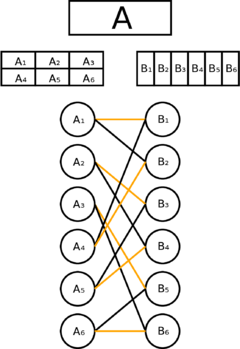TU Wien:Diskrete Mathematik für Informatik UE (Gittenberger)/Übungen WS13/Beispiel 33
Given a subset which has area and two decomposition of into subsets and such that all the ’s and all the ’s have the same area . Prove that there exists a permutation of such that for all we have .
Solution[Bearbeiten | Quelltext bearbeiten]
For every area and we draw a node. For every set and which share a common area () we draw an undirected edge between their nodes. From this construction we get a bipartite graph. To show that there exists a permutation we need to find an edge matching where every node occurs exactly once (perfect matching). The Figure below shows an example for two compositions and a possible permutation .

According to König's theorem the number of edges in a perfect matching equals the number of nodes in a minimum vertex cover. Since we need either all nodes or to get a minimum vertex cover (Why?? Example from Wikipedia: http://upload.wikimedia.org/wikipedia/commons/2/2e/Koenigs-theorem-graph.svg - not every vertex from A or B is used. The only thing I can come up with is, that every vertex is connected to at least one distinct vertex in B (when A = B, so all Ai = Bi) or have additional edges (when moving the areas a little bit, they will still overlap there Bi, but also other areas. But this would already be a proof for the whole thing. Any other ideas? — no nodes of either group are directly connected to each other — we need nodes to construct a minimal vertex cover. This means a perfect matching with edges exist. This matching gives us a correct permutation since each node in this edge matching must occur exactly once.
Scheint nicht ganz zu stimmen, siehe: https://math.stackexchange.com/questions/1511777/reformulating-a-problem-as-graph-theoretic
Alternative Solution (suggestion)[Bearbeiten | Quelltext bearbeiten]
Using the graph model from above, let and . Until now we have a model, and we know that for the permutation to exist, there must be a complete (i.e. perfect) matching in our graph. So we need to show that such a matching exists for all m. Now observe some properties of the graph:
- , since both L and R are decompositions into m parts.
- Every is connected to at least one - Since both decompositions cover the whole area of A, the area covered by any one element of one decomposition must also be covered in the other decomposition.
- Because every element in L is connected to at least one element in R, we can state that , i.e. the neighborhood of every set of elements on the left has at least as many elements as the set itself.
These are exactly the conditions under which a complete matching exists according to Hall's Marriage Theorem - which is known to be true ;) - so we're done here.